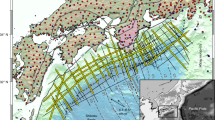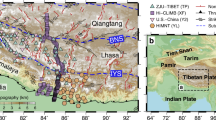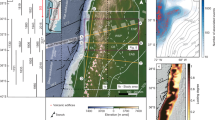Abstract
Subduction zones worldwide exhibit remarkable variation in seismic activity over short distances of about tens of kilometres along their length. The properties of the subducting oceanic plate are believed to influence this seismic behaviour. However, comparisons between seismicity and plate attributes such as thermal structure made over large scales of hundreds of kilometres typically yield poor correlations1,2. Here we present results from controlled-source seismic data collected offshore of the Alaska Peninsula. We find that fabric in the subducting oceanic plate—the orientation and style of remnant faults originally created at the mid-ocean ridge—can contribute to abrupt changes in faulting and hydration of the plate during bending before subduction. Variations in fabric, bending faulting and hydration correlate with changes in seismicity throughout the subduction zone. More interplate and intermediate-depth intraplate earthquakes are observed where the pre-existing fabric is aligned with the trench and there is more bend faulting and hydration. This suggests that pre-existing structures in the subducting plate are an important control on abrupt variations in deformation and plate hydration and on globally observed short-wavelength variations in seismicity at subduction zones.
This is a preview of subscription content, access via your institution
Access options
Subscribe to this journal
Receive 12 print issues and online access
$259.00 per year
only $21.58 per issue
Buy this article
- Purchase on Springer Link
- Instant access to full article PDF
Prices may be subject to local taxes which are calculated during checkout


Similar content being viewed by others
References
Barcheck, C. G., Wiens, D. A., van Keken, P. E. & Hacker, B. R. The relationship of intermediate- and deep-focus seismicity to the hydration and dehydration of subduction slabs. Earth Planet. Sci. Lett. 349, 153–160 (2012).
Hacker, B. R. H2O subduction beyond arcs. Geochem. Geophys. Geosyst. 9, Q03001 (2008).
Davies, J., Sykes, L., House, L. & Jacob, K. Shumagin seismic gap, Alaska Peninsula: History of great earthquakes, tectonic setting, and evidence for high seismic potential. J. Geophys. Res. 86, 3821–3855 (1981).
Fournier, T. J. & Freymueller, J. T. Transition from locked to creeping subduction in the Shumagin region, Alaska. Geophys. Res. Lett. 34, L06303 (2007).
Abers, G. A. Relationship between shallow- and intermediate-depth seismicity in the eastern Aleutian subduction zone. Geophys. Res. Lett. 19, 2019–2022 (1992).
Sella, G. F., Dixon, T. H. & Mao, A. REVEL: A model for recent plate velocities from space geodesy. J. Geophys. Res. 107, ETG 11-1–ETG 11-30 (2002).
Plafker, G., Moore, J. C. & Winkler, G. R. in The Geology of Alaska (eds Plafker, G. & Berg, H. C.) 389–449 (Geological Society of America, 1994).
Lonsdale, P. Paleogene history of the Kula plate: Offshore evidence and onshore implications. Geol. Soc. Am. Bull. 10, 733–754 (1988).
Bécel, A., Shillington, D. J., Nedimović, M. R., Webb, S. C. & Kuehn, H. Origin of dipping structures in fast-spreading oceanic lower crust offshore Alaska imaged by multichannel seismic data. Earth Planet. Sci. Lett. 424, 26–37 (2015).
Kobayashi, K., Nakanishi, M., Tamaki, K. & Ogawa, Y. Outer slope faulting associated with the western Kuril and Japan trenches. Geophys. J. Int. 134, 356–372 (1998).
Masson, D. G. Fault patterns at outer trench walls. Mar. Geophys. Res. 13, 209–225 (1991).
Ranero, C. R., Phipps Morgan, J., McIntosh, K. & Reichert, C. Bending-related faulting and mantle serpentinization at the Middle America trench. Nature 425, 367–373 (2003).
Christensen, D. H. & Ruff, L. J. Seismic coupling and outer rise earthquakes. J. Geophys. Res. 93, 13421–413444 (1988).
Emry, E. L., Wiens, D. A. & Garcia-Castellanos, D. Faulting within the Pacific plate at the Mariana Trench: Implications for plate interface coupling and subduction of hydrous minerals. J. Geophys. Res. 119, 3076–3095 (2014).
Ivandic, M., Grevemeyer, I., Berhorst, A., Flueh, E. R. & McIntosh, K. Impact of bending related faulting on the seismic properties of the incoming oceanic plate offshore of Nicaragua. J. Geophys. Res. 113, B05410 (2008).
Fujie, G. et al. Systematic changes in the incoming plate structure at the Kurile trench. Geophys. Res. Lett. 40, 88–93 (2013).
Christensen, N. I. Serpentinites, peridotites, and seismology. Int. Geol. Rev. 46, 795–816 (2004).
Carlson, R. L. & Miller, D. J. Mantle wedge water contents estimated from seismic velocities in partially serpentinized peridotites. Geophys. Res. Lett. 30, 1250 (2003).
Van Avendonk, H. J. A., Holbrook, W. S., Lizarralde, D. & Denyer, P. Structure and serpentinization of the subducting Cocos plate offshore Nicaragua and Costa Rica. Geochem. Geophys. Geosyst. 12, Q06009 (2011).
Kirby, S. H., Stein, S., Okal, E. A. & Rubie, D. C. Metastable mantle phase transformations and deep earthquakes in subducting oceanic lithosphere. Rev. Geophys. 34, 261–306 (1996).
van Keken, P. E., Hacker, B. R., Syracuse, E. M. & Abers, G. A. Subduction factory 4: Depth-dependent flux of H2O from subduction slabs worldwide. J. Geophys. Res. 116, B01401 (2011).
Jiao, W., Silver, P. G., Fei, Y. & Prewitt, C. T. Do intermediate- and deep-focus earthquakes occur on pre-existing weak zones? An examination of the Tonga subduction zone. J. Geophys. Res. 105, 28125–128138 (2000).
Ranero, C. R., Villaseñor, A., Morgan, J. P. & Weinrebe, W. Relationship between bend-faulting at trenches and intermediate depth seismicity. Geochem. Geophys. Geosyst. 6, Q12002 (2005).
Kelemen, P. B. & Hirth, G. A periodic shear-heating mechanism for intermediate-depth earthquakes in the mantle. Nature 446, 787–790 (2007).
Ruff, L. J. Do trench sediments affect great earthquake occurrence in subduction zones? Pageoph 129, 263–282 (1989).
Scholz, C. H. & Small, C. The effect of seamount subduction on seismic coupling. Geology 25, 487–490 (1997).
Scholz, C. H. The Mechanics of Earthquakes and Faulting (Cambridge Univ, Press, 1990).
Saffer, D. M. & Tobin, H. J. Hydrogeology and mechanics of subduction zone forearcs: Fluid flow and pore pressure. Ann. Rev. Earth Planet. Sci. 39, 157–186 (2011).
Maus, S. et al. EMAG2: A 2-arc min resolution Earth magnetic anomaly grid compiled from satellite, airborne, and marine magnetic measurements. Geochem. Geophys. Geosyst. 10, Q08005 (2009).
Bird, P. An updated digital model of plate boundaries. Geochem. Geophys. Geosyst. 4, 1027 (2003).
Choo, J., Downton, J. & Dewar, J. LIFT: A new and practical approach to noise and multiple attenuation. First Break 22, 39–43 (2004).
Caress, D. W. & Chayes, D. N. in Proc. of the IEEE Oceans 95 Conf. 997–1000 (MTS/IEEE, 1995).
Hobro, J. W. D., Singh, S. C. & Minshull, T. A. Three-dimensional tomographic inversion of combined reflection and refraction seismic traveltime data. Geophys. J. Int. 152, 79–93 (2003).
Engdahl, E. R., van der Hilst, R. & Buland, R. Global teleseismic earthquake relocation with improved travel times and procedures for depth determination. Bull. Seismol. Soc. Am. 88, 722–743 (1998).
Korenaga, J. et al. Crustal structure of the southeast Greenland margin from joint refraction and reflection seismic tomography. J. Geophys. Res. 105, 21591–521614 (2000).
Acknowledgements
We gratefully acknowledge the captain, technical staff and crew of the RV Marcus G. Langseth and the Scripps OBS team, who made this data set possible through their remarkable dedication in a challenging environment. This work was supported by the National Science Foundation. We thank J. Gaherty and N. Miller for helpful feedback.
Author information
Authors and Affiliations
Contributions
D.J.S., M.R.N. and S.C.W. obtained financial support for the marine seismic programme, and G.A.A., K.M.K. and D.J.S. obtained financial support for onshore seismic deployment through NSF grants. D.J.S., A.B., M.R.N., H.K., S.C.W., J.L. and M.D. collected marine data during a research cruise on RV Langseth, and K.M.K. and D.J.S. deployed and recovered onshore seismometers. D.J.S., A.B., M.R.N., H.K. and J.L. analysed marine seismic data, and D.J.S., G.A.A., K.M.K. and G.A.M.-S. analysed seismicity data. D.J.S. wrote the manuscript with contributions from all other authors.
Corresponding author
Ethics declarations
Competing interests
The authors declare no competing financial interests.
Supplementary information
Supplementary Information
Supplementary Information (PDF 22057 kb)
Rights and permissions
About this article
Cite this article
Shillington, D., Bécel, A., Nedimović, M. et al. Link between plate fabric, hydration and subduction zone seismicity in Alaska. Nature Geosci 8, 961–964 (2015). https://doi.org/10.1038/ngeo2586
Received:
Accepted:
Published:
Issue Date:
DOI: https://doi.org/10.1038/ngeo2586
This article is cited by
-
The nature of the Pacific plate as subduction inputs to the northeastern Japan arc and its implication for subduction zone processes
Progress in Earth and Planetary Science (2023)
-
Pressure-driven processes explain the decreasing magnetization of the subducting oceanic crust in the Japan Trench
Communications Earth & Environment (2023)
-
Forearc seismogenesis in a weakly coupled subduction zone influenced by slab mantle fluids
Nature Geoscience (2023)
-
Trench-parallel ridge subduction controls upper-plate structure and shallow megathrust seismogenesis along the Jalisco-Colima margin, Mexico
Communications Earth & Environment (2023)
-
Relationship Between the High-Amplitude Magnetic Anomalies and Serpentinized Fore-Arc Mantle in the Cascadia Subduction Zone
Pure and Applied Geophysics (2023)



